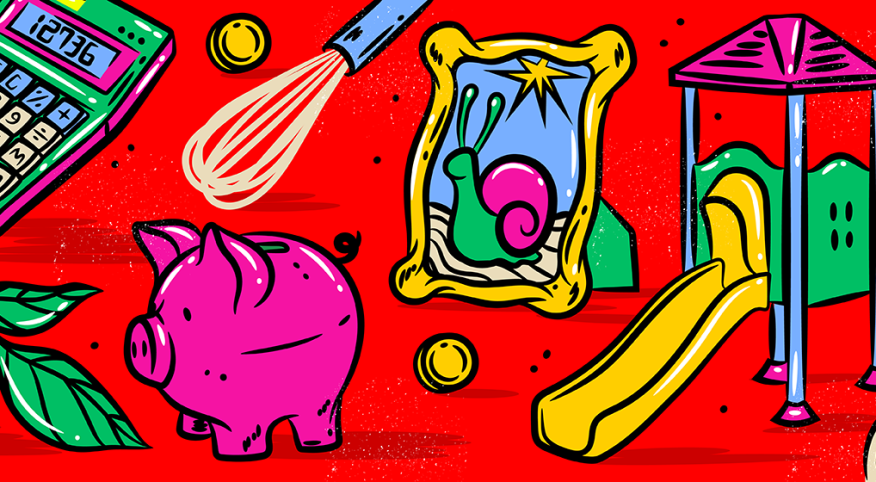If you’re looking for a reason to believe in humanity and the goodness of people again, these groups are a great place to start.
For as long as she can remember, Tanetta Caleb has been on the hunt for a deal. Growing up, her mother owned several consignment shops, and she learned the value of paying next to nothing for quality items to save money. As an adult, Caleb continued the tradition, buying items that were used, or even better, picking up free stuff on the side of the road. “There’s no shame in my game!” she says. When she became pregnant with her child in 2012, she joined her first buy-nothing group because she saw it as an exciting opportunity to scoop up gently used baby items for the low.
Caleb has been a conscious consumer since she was a little girl, but the pandemic has created a new wave of people who are more interested in participating in a gift economy.
A gift economy is exactly what it sounds like — it’s a culture where items are exchanged instead of sold. You may be asking yourself, what’s the catch? And it brings me great joy to tell you there isn’t one. In fact, gift economies aren’t as weird or new as they may sound. Think about it: You’ve probably hosted people over for dinner or received clothing from friends who may have outgrown it. Those are both examples of a gift economy, they just happen to be limited by who you know.
She used her group to get rid of some of the things her family didn’t use on a regular basis like an old Christmas tree and a patio table, but also to collect more of the items she’d need going forward, like homeschool supplies and a playground set.
Buy-nothing groups use the power of technology and the scale of social media to extend your reach beyond your personal network to others in your community that you may not have met otherwise. When Courtney Van Rosendale joined her Austin, Texas-based buy-nothing group in late 2019, she was becoming a stay-at-home parent and needed to make room in the house to homeschool her children. She used her group to get rid of some of the things her family didn’t use on a regular basis like an old Christmas tree and a patio table, but also to collect more of the items she’d need going forward, like homeschool supplies and a playground set.
Buy-nothing groups can range in size from a handful of members all the way up to hundreds of thousands. The Hawaii group that Alicia Cameron-Dzekedze initially joined out of curiosity back in 2018 eventually got up to 100,000 members and then split into smaller offshoots because members wanted it to be more localized. She now belongs to Buy Nothing Oahu, which has about 6,000 members, and has used it to get items like a fan during the summer after hers died, fresh mangoes, mason jars — even a couch!
Some groups have rules on what you can request or offer, but generally speaking, anything goes so don’t be shy. “The weirdest thing was a request for a snail picture,” Cameron-Dzekedze recalls. “It was for a lady’s son who loved them, and he even got a stuffed snail from another member.”
There are a few things to keep in mind. First, buy-nothing groups are hyper-local by nature and usually volunteer led. It’s not like eBay where people will ship you items from three states away, and if you’re unhappy with an item, there’s no manager who can address your issue. You’ll also want to keep your safety and security in mind when you’re arranging to meet someone. A lot of participants have moved to contactless exchanges, but there are still transactions that happen face-to-face. In those instances, be sure to suggest well-lit public locations like a police station or coffee shop. While there is a great deal of trust involved, these groups are meant to foster community sharing and, in most cases, they’re very successful. As another practical consideration, experienced thrifters also recommend inspecting items carefully and sanitizing them before bringing them into your home. Some avoid upholstered furniture.
If you want to find a buy-nothing group, start by searching Facebook and look for groups that are in your city or a larger hub nearby. Proximity is important because you need to make sure that you’re able to go and pick up your item. If social media isn’t an option, there is a global buy-nothing app that you can try. One of the benefits of the app is that you can curate your feed. However, unlike Facebook, the postings within the app aren’t moderated by administrators so you experience some delays with getting responses from inactive users.
If you’re looking for a reason to believe in humanity and the goodness of people again, these groups are a great place to start. In them, you get to witness real mutual aid and experience what it’s like to care for your neighbors. And the best part is there’s no shame or judgement in the ask because people are happy to give — that’s literally why they’re there! So, whether its baby formula for a mom whose SNAP benefits have run out or crutches for a woman who twisted her ankle and just needs them for a few weeks, it’s heartwarming to see people rise to the occasion. In times like this, we all need a reminder than we often have more to give than we think we do, and that’s the real gift here.











